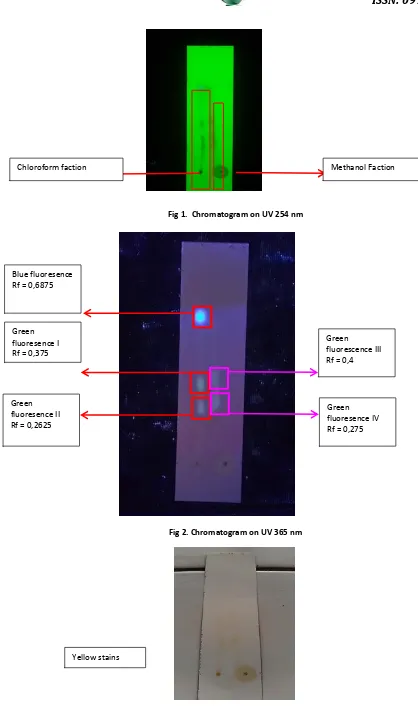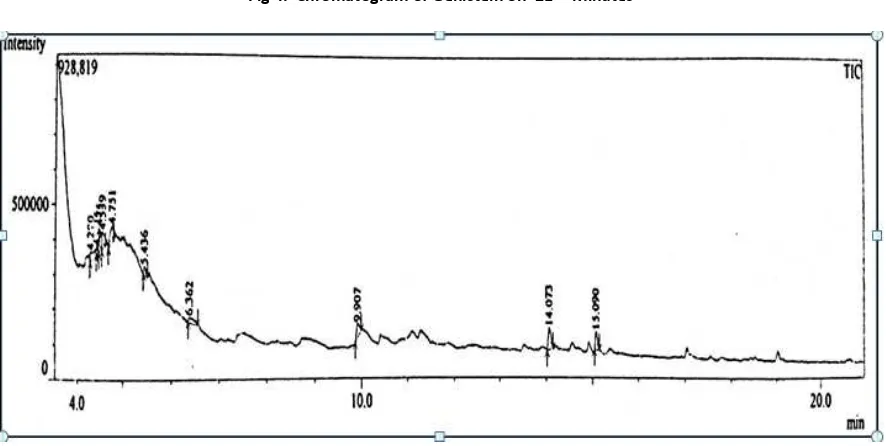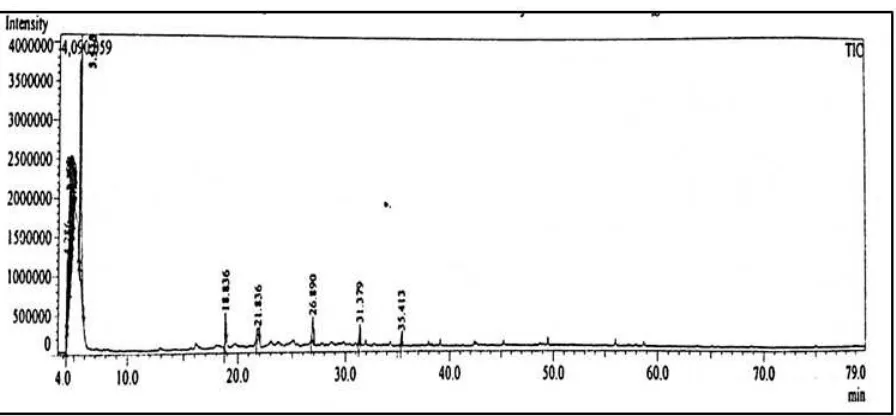ISSN: 0975-8585
November - December
2015
RJPBCS
6(6)
Page No. 502
Research Journal of Pharmaceutical, Biological and Chemical
Sciences
The Antioxidant Substances Profile of
Glycine max
L. Merr. Var. Detam II
Ultrasonic Extract.
Rika Yulia
1, Juliana Christyaningsih
2, and Vivian Irmasari
1.
1
Department of Farmacy, Surabaya University, Indonesia. 2
Surabaya Health Polytechnic, Surabaya, Indonesia.
ABSTRACT
Soybean is known to be the best source of isoflavone and antioxidant. Black soybean var. Detam II is proven to decrease the lead level in lead intoxicated mice, so that the antioxidant of black soybean var. Detam II extract is held. Defatted black soybean was extracted with methanol, hydrolyzed with HCl, then extracted with diethylether. The diethylether in the extract was evaporated until constant weight, then flavonoid was identificated by TLC and the active substances was analysed by GC-MS . The TLC result showed three unidentified flavonoids and the result by GC-MS showed Hexadecanoic acid, methyl ester, and Hexadecanoic acid, ethyl ester which three act as antioxidant. Neither isoflavone genistein substance was detected in black soybean var. Detam II extract with obtained by diethylether.
Keywords: soybean (Glycine max L. Merr.), profile of antioxidant, flavonoids.
ISSN: 0975-8585
November - December
2015
RJPBCS
6(6)
Page No. 503
INTRODUCTION
Free radicals are molecules with one or more unpaired electrons in their outer layers. Free radicals can be ROS (Reactive Oxygen Species) and RNS (Reactive Nitrogen Species) and in high levels, ROS and RNS can cause oxidative stress. Oxidative stress is defined as a condition where there is an imbalance between the formation and both ROS and RNS neutralization by antioxidants. Oxidative stress plays a major role in the development of chronic and degenerative diseases such as cancer, arthritis, autoimmune diseases, cardiovascular, neurodegenerative, aging process and the pathogenesis of menopause (Doshi and Agarwal , 2013 ; Pham - Huy et al . , 2008; Terzic and Dotlic, 2013).
The body has several mechanisms to cope with oxidative stress by producing antioxidants. Antioxidants are defined as molecules that delay, impede and prevent the oxidation of other molecules to capture free radicals and decrease oxidative stress. Endogenous antioxidant naturally in the body, whereas exogenous antioxidants can be divided into synthetic antioxidants and natural antioxidants, which are obtained from food or supplement. However, the use of synthetic antioxidants can give side effects are liver damage and carcinogenesis (Astuti, 2008; Dai and Mumper, 2010; Meenakshi et al., 2009; Sarma et al., 2010).
Natural antioxidant derived from plants, was found abundant in plants that contain phenolic compounds. One of the phenolic compounds that act as antioxidants are isoflavones or flavonoid (Astuti, 2008). Isoflavones are distributed in the plant family Leguminosae (Fabaceae) or nuts/soya. Soy is a source of isoflavones and also contain phytochemical compounds such as caffeic acid, ferulic acid, a mixture of tocopherols of natural and D-alpha tocopherol, vitamin C, saponins, phytic acid, anthocyanin pigments, and
unsaturated fatty acids which also have activity as antioxidants (Asih , 2009; Luthria et al , 2007; Popović et al .
, 2013 ; Yaoet al. , 2010) . The content of isoflavones in soy may vary between 0.4 to 9.5 mg of total isoflavones per gram ( Luthria et al . , 2007).
The content of active compounds such as isoflavones in soy is different influenced by many factors such as time of planting , harvesting time, a place to grow , the environmental conditions and genetic variation (varieties) Differences in the content of isoflavones in soy can affect the activity of isoflavone as an antioxidant and estrogen- like effect (Carrao -Panizzi et al. , 2009; Teekachunhatean et al. , 2013). Influence of varieties as one of the factors that affect the biological activity of soy have been studied previously . Anjasmoro methanol extract of soybean varieties is proven to reduce levels of lead (Pb) in the blood of mice terintoksikasi Pb , but not significant in lowering the levels of MDA in the liver and kidneys . The extract of soybean varieties Burangrang with methanol shown to have antioxidant activity with DPPH test method (Yulia et al. , 2014a ; Yulia et al. , 2015)
The extract of Glycine max L. Merr . Detam II varieties was given to lead intoxication mice, proven to reduce levels of lead in the blood and reduce organ damage significantly (Yulia et al. , 2014b). In addition, black soya also shown to have scavenging activity or capturing free radicals, ferric reducing power, and the total compound phenolic as higher than yellow soybeans. It was concluded that black soybeans have antioxidant activity greater than yellow soybeans (Dajanta et al., 2013).
MATERIALS AND METHODS
Plant Material
The plant material in this study were the seeds of black soybean (Glycine max L. Merr.) Detam II varieties. Sertificates of the varieties were taken from UPBS (Management Unit Seed) Balitkabi (Crops Research Institute for Legumes and Tuber) Malang on 10 October 2014, were harvested on June 26, 2014
Chemical Material
ISSN: 0975-8585
November - December
2015
RJPBCS
6(6)
Page No. 504
Equipment
The tools in this study were analytical balance Ohaus PA - 214, a blender ( grinder ), sieve mesh 20, the filter paper, vacuum pumps, laboratory glassware, thermometers, capillary tube, chamber, Ultrasonic Bransonic 8510 44 kHz , syringe filters, membrane filters 0.2 μm, syringe, kinetic maceration (stirring Motor IKA RW 20 N) with 10 rpm stirring speed, rotary evaporator (BUCHI Rotavapor R - 114), electric water bath (BUCHI Waterbath B - 480), UV lamps Camag, GC-MS Shimadzu QP - 2010 Plus , GC capillary columns Restek Rtx® - 5ms semipolar (Crossbond® 5 % diphenyl / 95 % dimethyl polysiloxane).
Manufacture of Extract of Black Soybean ( Glycine max L. Merr . ) Varieties Detam II
Black soya beans (Glycine max L. Merr.) Detam II varieties were cleaned and then were dried with aerated. Soy bean grinding was done by using a blender to make soy beans into powder. The powder obtained sieved using a 20 mesh -sized sieve to obtain a fine powder and uniform. Five hundred grams powder was carried defatting using 2 x 1 L of n - hexane with a kinetic maceration (Stirring Motor IKA RW 20 N) with a stirring speed of 10 rpm for 1 hour, after that, the filtrate separated from the pulp by means filtered.
Dregs were extracted using 1.5 L of methanol to 50% in 8510 Bransonic ultrasonic bath kHz60 44 ± 2 ° C for 10 minutes, then the filtrate was separated from the residue by means of methanol extract filtered and obtained first. The dregs in the same manner to obtain a second methanol extract. The first and second methanol extract was mixed, were concentrated using a rotary evaporator (BUCHI Rotavapor R - 114 ) and then carried out using 75.5 ml of HCl hydrolysis 2N with tool kinetic maceration (Stirring Motor IKA RW 20 N) with a stirring speed of 10 rpm for 2 hours
After that the soy’s extract was taken fifth part and that has been hydrolyzed and extracted using 100
ml of diethylether for 3 times using a separating funnel. Extract of soybean with diethylether obtained was concentrated waterbath (BUCHI Waterbath B - 480) to constant weight.
Extraction of Soybean Seeds In Ultrasound
Powder of Black soybean Detam II was sieved to 20 mesh and then obtained soybean powder with a weight 494.8168 g. The powder of Soybean obtained was extracted by maceration kinetic using 1 L of n-hexane twice and separated between filtrate with the dregs. The dregs was extracted using 1.5 L of 50 % methanol with ultrasonic bath at a temperature of 60 ± 2 ° C for 10 minutes
The extract of soybean with methanol was concentrated using a rotary evaporator and hydrolysis performed using 75.5 ml of 2N HCl for 2 hours. After the extract obtained is hydrolyzed by 800 ml, 160 ml one-fifth, its part were extracted with 100 ml of diethylether using the funnel three times. The extract of soybean with diethylether obtained was concentrated using a water bath until a constant weight. After the extract was concentrated viscous blackish brown and smelling herbs rather vague.
RESULT AND DISCUSSION
Identification of Flavonoids In Black Bean Extract Diethylether Detam Ii With TLC
ISSN: 0975-8585
November - December
2015
RJPBCS
6(6)
Page No. 505
Fig 1. Chromatogram on UV 254 nm
Fig 2. Chromatogram on UV 365 nm
Fig 3. Chromatogram on visible light with Amonia vapor
Chloroform faction Methanol Faction
Blue fluoresence Rf = 0,6875
Green fluoresence I Rf = 0,375
Green fluoresence II Rf = 0,2625
Green fluorescence III Rf = 0,4
Green fluoresence IV Rf = 0,275
ISSN: 0975-8585
November - December
2015
RJPBCS
6(6)
Page No. 506
The results were observed at 254 nm UV light showed stains of each fraction of chloroform and methanol. At 365 nm UV, the results indicate the presence of blue and green fluorescent stain chloroform fraction, and show a green fluorescent stain of methanol fraction. Once given the reagent vapor and ammonia were observed in visible light, visible presence of a faint yellow stain fading fast on the results of this TLC. Its prove the flavonoid content of the extract tested .
Qualitative Analysis Of Black Bean Extract Diethylether Detam II By GC – MS
The genistein standard with a concentration of 100 ppm was prepared by dissolving 0.3 mg in 3 ml of methanol. The extract of black soybean detam II with Diethylether was weighed a certain amount and diluted with methanol to a concentration of 6000 ppm. The extract was filtered using a syringe and a membrane filter of 0.2 µm. After the analysis, the standard (time of analysis 21 minutes ) and extract (time of analysis 21 and 80 minutes ) were using GC - MS .
Fig 4. Chromatogram of Genistein on 21th Minutes
ISSN: 0975-8585
November - December
2015
RJPBCS
6(6)
Page No. 507
Fig 6. Chromatogram of extract black soy Detam II with diethyl eter on 80th minutes
The standard chromatogram of genistein was found two peaks ( peaks ) is on Rt = 3,718 minutes with the component name 2-chloroethanesulfonyl chloride based library NIST08s.LIB and Rt = 14,364 minutes with the component name tetracontane based library WILEY8.LIB. There is no database owned genistein in library, so it is concluded that genistein is not detected. The chromatogram of extract of black soybean Detam II with diethylether were many peaks which are compounds contained in the extract. Ten peak with the highest intensity are identified by comparing the mass spectra of compounds with MS fragmentation patterns that exist in the instrument library GC- MS Shimadzu QP - 2010 Plus. The following names identified compounds in the extract with the analysis time 21 and 80 minutes.
Table 1. The content of compounds that are antioxidants in Black Soybean Extract Detam II using GC - MS in 21 Minutes
Rt (minutes) Component Library
14.075 Hexadecanoic acid, methyl ester NIST08s.LIB
15.090 Hexadecanoic acid, ethyl ester WILEY8.LIB
Luiz (2013) observed the nutritional composition and biological potency of widely consumed sprouts from the three species - Glycine max (L.) Merr, Vigna radiata L. and Medicago sativa L. It is showed phenolic compounds and phytosterols were analyzed by HPLC-DAD and organic acids by HPLC-UV. Fourteen phenolic compounds were found by GC-IT / MS consists of four iso-flavones, three sterols one triterpene, fatty acids sixteen, seven thirty organic acids and volatile compounds. The antioxidant activity of the unknown
sample with analysis of DPPH •, superoxide and nitric oxide radicals. Sprouts from G. max were most active against DPPH • (IC50 = 1.337 mg / mL), whereas that of M. sativa is the most effective against superoxide and
nitric oxide radicals (IC50 = 67 ug / ml and IC50 = 426 mg / mL , each). There are similarities sprouts from G. max and M. sativa rich in phenolic compounds, and volatile fatty acids, and showed better antioxidant activity than Vigna radiata. The results of the above are different from that study that we did, because it depends on the composition of the solvent when obtaining extracts and soy sprouts are growing that contains isoflavones and other active substances are different than soy.
CONCLUSIONS
ISSN: 0975-8585
November - December
2015
RJPBCS
6(6)
Page No. 508
REFERENCES
[1] Asih, I A R A, 2009, Isolasi dan identifikasi senyawa isoflavon dari kacang kedelai (Glycine max). Jurnal Kimia FMIPA Universitas Udayana. 3 (1): 33-40.
[2] Astuti S, 2008, Isoflavon kedelai dan potensinya sebagai penangkap radikal bebas. Jurnal Teknologi Industri dan Hasil Pertanian. 13 (2): 126-136.
[3] Carrão-Panizzi M C, Berhow M, Mandarino J M G, et al, 2009, Environmental and genetic variation of isoflavone content of soybean seeds grown in Brazil. Pesq. Agropec. 44 (11): 1444-1451.
[4] Dai J, Mumper R J, 2010, Plant Phenolics: Extraction, Analysis and Their Antioxidant and Anticancer Properties. Molecules. 15: 7313-7352.
[5] Dajanta K, Janpum P, Leksing W, 2013, Antioxidant capacities, total phenolics and flavonoids in black and yellow soybeans fermented by Bacillus subtilis: A comparative study of Thai fermented soybeans (thua nao). International Food Research Journal. 20 (6): 3125-3132.
[6] Doshi S B, Agarwal A, 2013, The Role of Oxidative Stress in Menopause. Journal of Mid-Life Health. 4 (3): 140-146.
[7] Luís R. Silva, Maria J. Pereira, Jessica Azevedo, Rui F. Gonçalves, Patrícia Valentão, Paula Guedes de Pinho, Paula B. Andrade, 2013, Glycine max (L.) Merr., Vigna radiata L. and Medicago sativa L. sprouts: A natural source of bioactive compounds, Food Research International, 50:167-175
[8] Luthria D L, Biswas R, Natarajan S, 2007, Comparison of Extraction Solvents and Techniques Used for The Assay of Isoflavones from Soybean. ELSEVIER Food Chemistry. 105: 325-333.
[9] Meenakshi S, Gnanambigai D M, Tamil mozhi S, et al, 2009, Total Flavanoid and in vitro Antioxidant Activity of Two Seaweeds of Rameshwaram Coast. Global Journal of Pharmacology. 3 (2): 59-62. [10] Pham-Huy L A, He H, Pham-Huy C, 2008, Free Radicals, Antioxidants in Disease and Health.
International Journal of Biomedical Science. 4 (2): 89-96.
[11] Popović B M, Štajner D, Mandić A, et al, 2013, Enhancement of Antioxidant and Isoflavones Concentration in Gamma Irradiated Soybean. Hindawi. 1-5.
[12] Sarma A D, Mallick A R, Ghosh A K, 2010, Free Radicals and Their Role in Different Clinical Conditions: An Overview. International Journal of Pharma Sciences and Research (IJPSR). 1 (3): 185-192.
[13] Teekachunhatean S, Hanprasertpong N, Teekachunhatean T, 2013, Factors Affecting Isoflavone Content in Soybean Seeds Grown in Thailand. Hindawi, 1-12.
[14] Terzic M M, Dotlic J R, 2013, Phytoestrogens in gynecology - antioxidative role. Oxidants and Antioxidant in Medical Science. 2 (1): 1-4.
[15] Yao Q, Xiang-nan J, Dong P H, 2010, Comparison of Antioxidant Activities in Black Soybean Preparations Fermented with Various Microorganism. Science Direct. 9 (7): 1065-1071.
[16] Yulia R, Karina L, Veronica, et al, 2014a, Efek Glycine Max Varietas Anjasmoro terhadap Kadar Timbal dan Malondialdehid pada Mencit Terintoksikasi Timbal. Jurnal Farmasi Indonesia. 7 (1): 27-33. [17] Yulia R, Ressandy S S, Puspikaryani G A P, et al., 2014b, Glycine max Detam II Variety as Preventive
and Curative Organ Damage Due to Exposure to Lead (Pb). International Conference on Pharmaceutics and Pharmaceutical Sciences 2014.


